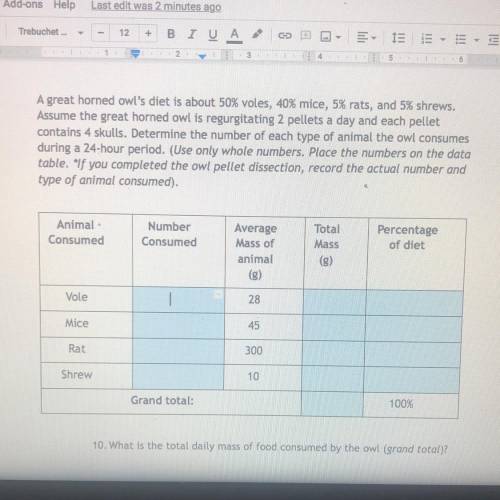
A great horned owl's diet is about 50% voles, 40% mice, 5% rats, and 5% shrews.
Assume the great horned owl is regurgitating 2 pellets a day and each pellet
contains 4 skulls. Determine the number of each type of animal the owl consumes
during a 24-hour period. (Use only whole numbers. Place the numbers on the data
table. If you completed the owl pellet dissection, record the actual number and
type of animal consumed).
Animal-
Consumed
Number
Consumed
Average
Mass of
animal
(g)
Total
Mass
(g)
Percentage
of diet
Vole
28
Mice
45
Rat
300
Shrew
10
Grand total:
100%


Answers: 1


Another question on Biology

Biology, 21.06.2019 20:00
You have been asked to lead a demonstration for the undergraduate microbiology lab course about the uses of negative staining when studying bacteria. a "negative" stain does not stain the bacterial cell itself but stains the space between cells. under magnification, the acidic (negativelycharged) nature of the stain will be repelled by the negatively charged bacterial cell wall and willleave the cell colorless in a stained background. negative stains are used primarily to reveal the presence of negatively charged bacterial capsules; therefore, they are also called capsule stains. encapsulated cells appear to have a halo surrounding them. the negative stain procedure does not require heat fixation, which limits any chances of alteration in bacterial cell shape and size. the bacterial suspension is added to a drop of stain, such as nigrosin or eosin, and drawn across the glass slide using a coverslip.nigrosin staining-not safranin staining-of klebsiella pneumoniae will allow for the visualization of the cell shape and the determination of the presence of a capsule.true/false
Answers: 1

Biology, 22.06.2019 11:50
Approximately what wavelength of light is best absorbed by chlorophyll a
Answers: 1

Biology, 22.06.2019 12:50
Aresearcher created three groups based on participants bmi: normal weight, overweight and obese. the hypothesis being tested is that the three groups differ in the mean number of artificially sweetened drinks consumed weekly. which statistical test might the researcher use, assuming a reasonably normal distribution of values.
Answers: 1

You know the right answer?
A great horned owl's diet is about 50% voles, 40% mice, 5% rats, and 5% shrews.
Assume the great ho...
Questions

Mathematics, 11.10.2020 14:01

Biology, 11.10.2020 14:01


English, 11.10.2020 14:01

Mathematics, 11.10.2020 14:01


Mathematics, 11.10.2020 14:01


Mathematics, 11.10.2020 14:01



Mathematics, 11.10.2020 14:01



Chemistry, 11.10.2020 14:01

Chemistry, 11.10.2020 14:01


History, 11.10.2020 14:01


Mathematics, 11.10.2020 14:01



